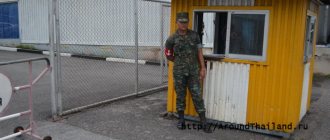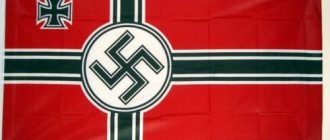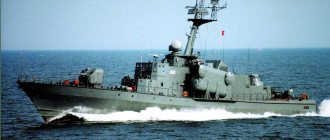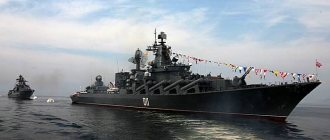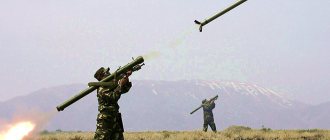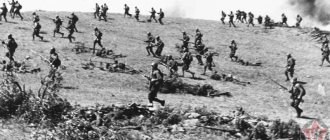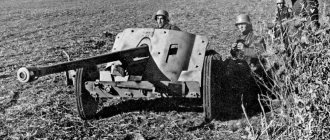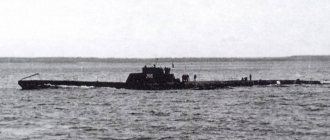Home » Alternative shipbuilding - Fleets that never existed » Fleet of the alternative USSR 1935-1945
Alternative shipbuilding - Fleets that never existedAlternative shipbuilding - Fleets that never existed
Dmitry Yu 11/21/2018 2900
11
in Favoritesin Favoritesfrom Favorites 9
Another very old post, which was published in 2012.
Fleet of the alternative USSR 1935-1945
The well-known Russian proverb “If I knew where I fell, I would have put a straw” was also repeated by the Soviet saying “If I knew the purchase, I would live in Sochi.” In the article offered to your friendly attention, I will present a vision of the USSR fleet, which could have acted more successfully than the real one during the Second World War, if its creators had had the gift of foresight, or, in accordance with the recently popular genre of “alternative history”, would have turned out to be aliens from of the future (the so-called “fallen people”).
With gratitude to my colleague Andrey for his idea formulated in the materials
And
"Yamato"
The Japanese planned to build three battleships of this type, but two were completed - Yamato and Musashi. The third ship was converted into an aircraft carrier. They were designed to be the most armed and protected ships in the world. And also large ones - 260 m in length, with a displacement of 70 thousand tons.
In terms of the total weight of the salvo, the battleship was almost twice as fast as its European counterparts, and the fire control system was perfect. The installed armor was of maximum thickness; the Yamato turned out to be the most heavily armored ship in World War II. Despite the preparation, the battleships failed to achieve fame; in the end, they were sunk by American aircraft after desperate resistance.
Battleships were in service with all countries that could influence the course of World War II. The ships took part in many famous battles, but with varying degrees of success.
Soviet military shipbuilding (true story)
Soviet military shipbuilding went through three stages:
- from 1922 to 1927 - the stage of restoration, major repairs and completion of construction of ships laid down before the revolution;
- from 1927 to 1937 - the stage of extensive construction of the submarine fleet and small surface ships, laying down light cruisers based on documentation and technical assistance from Italian shipbuilders;
- from 1938 until the start of the war - the stage of the beginning of the construction of a large sea and ocean fleet.
By the beginning of the Great Patriotic War, the naval composition of the RKKF consisted of 3 battleships, 7 cruisers, 59 leaders and destroyers, 218 submarines, 269 torpedo boats, 22 patrol ships, 88 minesweepers, 77 submarine hunters and a number of other ships and boats, and also auxiliary vessels.
There were 219 ships under construction, including 3 battleships, 2 heavy and 7 light cruisers, 45 destroyers, 91 submarines.
Unfortunately, the expenses of the young Soviet republic for the construction and staffing of the fleet were not fully utilized by the course of military operations. By 4 o'clock in the morning on June 22, 1941, the order to put No. 1 on combat readiness not only reached bases, airfields, ships and coastal batteries - they had already managed to prepare to repel the attack, but it never occurred to anyone to give the order for the ships to go to sea ! Many Red Navy men fought on land with rifles in their hands, and warships rusted in the harbors. Hitler's Germany uninterruptedly supplied its industry with valuable raw materials, despite the fact that some communication lines ran close to the naval bases of the Soviet fleet.
https://ww2history.ru/voormorsil/3863-sovetskijj-flot-v-gody-velikojj-otechestvennojj.html
Netherlands
Submarines of the Royal Dutch Navy took an active part in the war. They have achieved good success operating in Southeast Asia.
O-16 (photo source)
The best Dutch submarine is considered to be the O-16 of Lieutenant Ter Zee 1st Class Anthony Jacobus Bussemaker.
The boat entered service with the fleet on October 26, 1936. Her fighting career was short but bright.
On December 12, 1941, O-16 successfully attacked Japanese transports off the coast of the Malay Peninsula. The boat's torpedoes sent three ships with a total tonnage of 27,000 GRT to the bottom.
And three days after this attack, the submarine was killed by mines off the island of Tioman.
Pages of real history that you want to rewrite:
Mine-artillery position
Soviet military theorists believed that the enemy fleet, gathered into a single fist, would rush across the entire Gulf of Finland to capture Leningrad. In conditions of overwhelming enemy superiority at sea, the main idea of the USSR naval strategy was a mine-artillery position. The formation and use of forces in these positions was taught at the Academy, and they were practiced in numerous exercises since the early 1930s. During this time, a whole generation of Soviet naval commanders grew up. They simply could no longer imagine how they could fight at sea except “from the trench” of a mine-artillery position. As a result of targeted operational and combat preparation, by the beginning of the 40s, the creation of mine and artillery positions was considered mandatory, and without any connection with the actual developing military-political situation. In reality, the practice of the Second World War showed that surface minelayers were a thing of the past, and NO POWER was based on it as a core idea. The battleships turned out to be poorly protected against air attacks by large forces, so it would have been quite possible to stop the supposed advance of the “armored fist” to Leningrad by the RKKF without the help of mines at all - at the expense of aviation, torpedo boats and submarines.
Towers of the battleship "Frunze" (formerly "Poltava").
Two three-gun turret installations of 305 mm caliber from the irreparable battleship Frunze (formerly Poltava) - the second and third - in the early 1930s. were installed on battery No. 981 named after. Voroshilov in Vladivostok. The remaining two towers were not used. In 1941, the rotating armor of one of the towers lying dismantled on the territory of the Leningrad Metal Plant named after. Stalin, was used in the construction of firing points for the ground defense of Leningrad. The experience of the combat use of the 30th battery near Sevastopol showed that installing main-caliber armored turrets on concrete casemates makes it possible to create an extremely invulnerable firing point of high power, and with proper anti-personnel cover and timely replacement of barrels, such a battery can fire at the enemy until the supply of shells is exhausted.
Tallinn transition - the evacuation of the main forces of the Baltic Fleet under the command of Vice Admiral V.F. Tributs from Tallinn to Kronstadt at the end of August 1941.
The events that occurred in the last days of August 1941 in the Gulf of Finland can be considered the most tragic not only in the Great Patriotic War at sea, but also in the history of the Russian Navy in general. It’s difficult to compare even with Tsushima: the personnel of warships still died there, but here it was mostly evacuees who entrusted their lives to military sailors. 225 ships and vessels left Tallinn, as a result, 62 were killed by mines and from attacks by German aircraft, 163 (72.4%) arrived in Kronstadt. Of the 41,992 people who left Tallinn, 15,111 people died; 26,781 people (64%) arrived in Kronstadt. A. Platonov’s book “The Tragedy of the Gulf of Finland” is dedicated to the tragedy: https://lib.rus.ec/b/228850/read
The death of the PQ-17 caravan. June-July 1942
Of the 35 transports, only 11 reached Arkhangelsk. 2 ships returned to Iceland. 22 transports with a total tonnage of more than 142 thousand tons were sunk by German submarines and aircraft IN THE SOVIET ZONE OF RESPONSIBILITY. 210 aircraft, 430 tanks, 3,350 cars and 99,316 tons of other general cargo went to the bottom. In addition to the transports, the rescue ship Zafaran and the squadron tanker Aldersdale were also sunk. Thus, the total number of PQ-17 losses was 24 ships. The losses of the ships' crews amounted to 153 people. Of these, only 7 died before the convoy was disbanded.
The convoy was covered by a cruising force under the command of British Admiral Louis Hamilton. It consisted of two British cruisers London and Norfolk, two American cruisers Tuscaloosa and Wichita and three destroyers (two of them American), which left the convoy IN THE SOVIET ZONE OF RESPONSIBILITY. To be fair, some of the blame should also be placed on the First Sea Lord of the Royal Navy Admiralty, Dudley Pound, who gave the ill-fated command to “disperse the convoy.” The Soviet Northern Fleet and the aviation units attached to it were too weak to independently provide reliable cover for convoys east of the 20th meridian, as the British wanted
The sinking of three Soviet warships in 1943 on the Black Sea
On October 5, 1943, the destroyer “Sposobny”, the destroyer “Besposhchadny” and the leader “Kharkov” set out on their next military campaign. The purpose of the operation was the destruction of German watercraft and landing ships returning from Kerch, as well as the shelling of the ports of Feodosia and Yalta. As a result of the artillery attacks on Yalta and Alushta, not a single German was injured, only a few civilians. All three Soviet ships were sunk by German aircraft. As a result, Stalin ordered the transfer of all large ships of the Black Sea Fleet to the reserve of the Supreme Commander-in-Chief Headquarters. They did not participate in hostilities anymore, and in May 1944, Soviet surface ships (except for torpedo boats) did not in any way prevent the Germans from carrying out a generally successful evacuation from Sevastopol to Constanta.
https://road-crimea.narod.ru/2004/6oct.htm
Germany's supply of nickel to the Petsamo mines through the port of Kirkenes in 1941-1944
Offensive military operations of the troops of the Karelian Front and the Northern Fleet of the USSR Navy against the Wehrmacht troops in northern Finland in the Petsamo region and northern Norway were carried out during the Petsamo-Kirkenes offensive operation, which was included in the so-called “10 Stalinist strikes”, from October 7 to October 1 November 1944.
Overall a successful offensive operation. However, located 60 km from the Rybachy Peninsula, the port of Kirkenes uninterruptedly supplied Germany with valuable strategic raw materials - nickel from the Petsamo mine - for an unacceptably long time (3 years - from 1941 to 1944).
Low efficiency of USSR submarines 1941-1945.
267 submarines of the USSR, of which 170 took part in hostilities, sank 126 targets during the war, which was the worst result among all the Fleets participating in the Second World War. The indicator of the USSR (0.74 sunk targets per one submarine participating in hostilities) turned out to be THREE times worse than the indicators of Great Britain (2.32 sunk targets per 1 submarine). As one example from a number of similar ones, we can consider the contribution of submarines to the disruption of the evacuation of Nazi troops from Crimea on April 9-May 12, 1944. In total, during this period, 11 submarines in 20 combat campaigns damaged one (!) transport. During April and twenty days of May, the enemy conducted 251 convoys! And these are many hundreds of targets and with very weak anti-submarine protection. A similar picture emerged in the Baltic in the last months of the war with the mass evacuation of troops and civilians from the Courland Peninsula and from the Danzig Bay area. In the presence of hundreds of targets, including large-tonnage ones, often with completely conditional anti-submarine protection, in April-May 1945, 11 submarines in 11 combat campaigns sank only one transport, a mother ship and a floating battery.
https://www.deol.ru/manclub/war/podlodka.htm
Norway
For Norwegian submariners, the fall of their country did not mean the end of the war. They continued fighting as part of the British Royal Navy, when the British handed over several of their submarines to their crews.
The best Norwegian submarine was the Ula.
This U-class boat made 14 voyages to the North and Norwegian Seas in 1943-44. During the campaigns, she sank three ships worth almost 7,000 GRT and the German submarine U 974. In addition, the submarine managed to damage three ships worth 12,500 GRT.
She achieved these successes under the command of Lieutenant Sigurd Valvatne, the best Norwegian submariner of World War II.
"Ula" in 1951
The British "Norwegian" survived the war and then became part of the Norwegian Navy.
HOW TO REWRITE THE PAGES OF HISTORY
Instead of exaggerated attention to the creation and combat operations at the “Mine-Artillery Position,” the RKKF should have concentrated on developing tactics for disrupting enemy communications with heterogeneous forces, using aircraft, torpedo boats and submarines. The mine war had to be planned exclusively near the ports of Germany, Sweden and Finland - with the help of underwater minelayers.
The remaining (first and fourth) two three-gun turret installations of 305 mm caliber from the irreparable battleship Frunze (formerly Poltava) should have been used to create a coastal battery on a concrete casemate, similar to battery 30 near Sevastopol or the Voroshilov battery near Vladivostok, for the defense of Leningrad.
The tragedy of the Tallinn crossing of 1941 was mainly caused by the human factor, and to some extent by the insufficient number of minesweepers and trawls (which in real history were not replaced after being blown up by mines and mine protectors). Many ideas can be proposed - from changing the route to changing the order of ships, and launching a dozen “barrage breakers” (civilian ships filled with barrels) in front of the column, immediately after the minesweepers, would significantly reduce losses. Unfortunately, both the Baltic Fleet as a whole and its individual formations and ships were often commanded by people who did not meet wartime requirements.
The death of the PQ-17 convoy indicated that the escort of the convoys should have been entrusted to the RKKF, while the British and Americans should have been given responsibility for the formation of long- and short-range cover detachments. To conduct convoys, it would be enough to concentrate 4 new cruisers and 8 seaworthy destroyers or leaders on the Northern Fleet. To counter large surface forces, it would be desirable to cover the convoy with a group of 4-6 submarines, optimally based on the German Type IX project. Additionally, I note that in my personal opinion, neither the Project 26 cruisers nor the Project 7 destroyers were optimal for the purposes of escorting Atlantic convoys; the project of a light cruiser of the Fiji type with twice the cruising range and more adequate artillery for the task would be better suited here (12x152 instead of 9x180mm ) and the Fletcher-class destroyer project.
The death of three Soviet warships in 1943 on the Black Sea showed that the reliance on the long-range, non-universal 130mm B13 gun did not justify itself: 130mm guns could not cause significant damage to the enemy when shelling coastal targets, and the air defense capabilities of Project 7 and 7u destroyers turned out to be insufficient. In general, the task of the operation (shelling of ports) did not correspond in any way to the means of accomplishing the task (destroyers with 130mm artillery). Additionally, I will express my personal opinion - not only the division commander Negoda, but also the commander of the Black Sea Fleet Vladimirsky and People's Commissar Kuznetsov, who were at the Black Sea Fleet checkpoint at that moment, performed unsatisfactorily.
An attack on the port of Kirkenes (optimally capture, minimum long-term disablement) would be optimally carried out using one or two coastal defense battleships Väinämöinen and Ilmarinen. The battleships should have been forcibly purchased from Finland after the victory in the Soviet-Finnish War, as was done after the victory in the Great Patriotic War. If it had not been possible to obtain battleships, then one Sevastopol-class battleship should have been transferred to the Northern Fleet. The Petsamo-Kirkenes offensive operation should have been carried out not in 1944, after three years of construction of bunkers by the Germans, but in the summer of 1941. In addition, it would be more convenient for landing forces to use special landing craft, rather than Torpedo Boats and Small Hunters.
It would be possible to increase the effectiveness of submarines, first of all, with the help of a different plan for combat training of submarine commanders in the period 1938-1940, different tactics of action, and, of course, with the help of more advanced submarines, and especially more advanced means of torpedo control salvo, communications and target detection.
In fact, RKKF, in my subjective opinion, deserved the rating “not satisfactory”. This impartial assessment in no way detracts from the courage and heroism of the Soviet Red Navy men and their commanders, who, in conditions for which they were not properly prepared before the war, did not spare their health and lives in the face of danger.
Greece
Although there were few Greek submarines, they also managed to achieve victories during the war. The most successful submarine is the Proteus, which has been part of the Greek Navy since 1929.
Submarine "Glavkos" of the same type as "Proteus"
On 29 December 1940, she attacked an Italian convoy in the southern Adriatic. Her torpedoes sent a large transport with a tonnage of 11,452 GRT to the bottom. However, immediately after this, the submarine died - it was rammed and sunk by an Italian destroyer.
To be continued…
WHY DID THIS HAPPEN?
The beginning of the 20th century for the Russian Navy was marked by the tragedy of the Russo-Japanese War. One of the reasons for the defeat was the erroneous personnel policy of the Imperial Navy of the Russian Empire. In this regard, Kuropatkin’s words deserve special attention: “Peacetime certifications largely turned out to be inconsistent during combat testing. The commanders who served everywhere “out of turn” on the battlefield did not withstand the combat test due to their physical and spiritual qualities. On the contrary, those who went through their careers unnoticed, in a combat situation unexpectedly deployed their deep spiritual forces and revealed outstanding military qualities.”
By the beginning of the First World War, a galaxy of admirals had formed that the fleets of any state could be proud of - primarily Kolchak and Essen. However, the Revolution, the Civil War and the policy of Stalin’s repressions did not resolve, but rather aggravated the personnel problems inherited from the Empire by the Fleet of the young republic. The overwhelming majority of personnel decisions during the “purge” turned out to be erroneous. As a result, due to the insufficient experience of the new command staff of all ranks, combat training in the fleets decreased. In addition, repressions weaned commanders from making independent decisions, forcing them to constantly coordinate them with their superiors.
Naval gunners had good training in firing at naval targets, which was devoted to a lot of time in naval schools. Little attention was paid to shooting at coastal targets. Meanwhile, it was coastal firing that became predominant during the naval operations.
The shipbuilding program changed many times during the period from 1927 to 1941, including with sad consequences for its authors. Technical specifications for weapons and military equipment did not always reflect modern requirements, as well as the real capabilities of the Soviet economy and industry.
A separate feature of the defense industry of the USSR was, and in many ways remained until the end of the twentieth century, a simplified approach to the creation of weapons and military equipment (WME): The main attention was focused on means of fire destruction of targets and reducing the cost of WME, while insufficient attention was paid to communications and detection means goals, control automation tools, as well as the comfort of military personnel. If in tank building and the creation of land artillery guns this approach turned out to be correct (“the T-34 had wide tracks, strong armor and a good gun, but nothing else remarkable”), then in shipbuilding, in general, it was not. It is precisely in the vast expanses of the sea that target detection methods determine the combat effectiveness of a ship to a greater extent than the firing range of the gun mount.
Submarines had fairly high tactical and technical characteristics, powerful weapons, and survivability, but until the last period of the war they did not receive high-speed and traceless torpedoes. The torpedo firing control devices required radical improvement. Due to the lack of high-quality sonars, the boats could not detect the enemy at sufficient distances. The tactics of using a submarine as a combat guard for a naval base, and the technical specifications for the Malyutka type that followed from such tactics, turned out to be erroneous.
The shortcomings of the combat strength of the fleets of the pre-war period include the lack of landing ships and a small number of minesweepers. Warships and vessels were unprotected from non-contact weapons. The first domestic non-contact trawls appeared in our fleet at the end of 1942.
USA
American submarines became famous for the destruction of Japanese ships in the Pacific Ocean. US submariners claimed to have sunk as many as 4,000 Japanese ships with a total tonnage of 10 million gross tons. However, after the war, the Joint Committee of the US Army and Navy to account for losses reduced the success of the submarine to 1314 ships with a tonnage of 5.3 million gross tons. (other data can be found in different sources. - Author's note).
It is curious that the Yankees assessed the success of their submarines not by the tonnage of ships and vessels sunk, but by the number of targets.
Therefore, two submarines became the best in the US Navy submarine fleet.
"Totog" (photo source)
According to the Joint Committee, the Totoga, a Tambor-class submarine, has the most sunk targets. During this time, Totog made 13 voyages and sank 26 ships totaling 72,606 GRT.
The Joint Committee gave the first place in sunk tonnage to the ship "Flasher". Over the course of six voyages, this Gateau-class submarine sent 21 ships worth 100,231 GRT to the bottom.
"Flasher"
Both submarines managed to survive the fighting. They were written off after the end of the war.
ALTERNATIVE HISTORY
Personnel
The first and main part, for me, is the footage, which, as I.V. said. Stalin, they decide everything.
In my alternate reality, personnel purges, both in the army and navy, were carried out on a much smaller scale, and without arrests or executions. Some of the incompetent commanders were demoted in rank and moved to less responsible positions. Personally, Vladimir Filippovich Tributs was dismissed from military service.
In 1937, an anachronism that, contrary to world experience and common sense, survived into the 21st century - the institution of political workers in the army and navy - should be completely curtailed in 1937. Given the huge shortage of disciplined and educated people, all political workers should have been retrained in military educational institutions, certified and partly appointed to command positions, and partly sent to the national economy.
This would have made it possible, by the beginning of WWII, to retain in the RKKF a noticeable part of the officers who could not be retained in the Republic of Ingushetia - including those with experience in the Imperial Navy, as well as those close to class and young, but ruff, who were repressed in 1937.
Unlike the RI, at the AI naval exercises of 1940, all ships and formations without exception received only “good” and “excellent” ratings. Hitting coastal targets took up 70% of firing exercises.
Foreign policy and military-technical cooperation.
It was possible to make friends with England and the USA not in 1941, but in 1935. Accordingly, the USSR exchanged friendship and military alliance for ship projects and technical assistance in shipbuilding with its future allies. On the contrary, the purchase of the heavy cruiser Lützow from Germany at the end of 1939 for 106.5 million marks in gold did not take place. Also with Italy, from which they did not buy the documentation and mechanisms of the light cruiser in 1935, and also did not receive technical assistance in the design and production of torpedoes and the Tashkent leader. However, German technical assistance in the creation of submarines, torpedo boats and torpedoes would be very useful.
The goals of the USSR Navy for the period 1935 - 1945, what they should have been.
— Preventing the threat to Leningrad and Sevastopol from the sea
— Active violation of enemy sea communications.
— Landing
— Fire support for ground forces in coastal theaters of military operations (TVD)
The main methods of achieving the goals of the USSR Navy for the period 1935 – 1945
— Preventing the threat to Leningrad and Sevastopol from the sea through aviation, a quickly deployed screen of submarines and “star” attacks by torpedo boats. Promptly deployed mine banks from underwater minelayers and fire from coastal batteries - as the last line of defense.
— Suppression of amphibious assaults and disruption of enemy communications using underwater minelayers, aircraft, destroyers, torpedo boats and submarines. In the ports of Petsamo and Kirkenes - with the help of a coastal defense battleship based in Murmansk.
— Landing of troops using specialized infantry landing and tank landing ships
— Fire support for ground forces in coastal theaters of operations using cruisers, coastal defense battleships and battleships
Shipbuilding program 1935 – 1940
If we consider the option of getting caught with a folder of drawings and the known date of the start of the war, then:
— The prisoner will need to grab drawings and technological maps for the 40mm Swedish anti-aircraft gun Bofors L60,
20mm ZAU
"Oerlikon",
as well as the German
7 Ge electric torpedo,
LMB bottom mine trawl (ship mine trawl designed to destroy bottom and anchor non-contact mines by exposing their fuses to artificially simulated physical fields).
— Projects of ships for the AltUSSR in the folder of the recipient: light cruiser of the “Fiji”
,
Fletcher
, Flower-class corvette
,
Type VII submarine
, LCI( L)
infantry landing ship .
Torpedo boat Schnellbot
(Germany)
— Projects are used “as is,” with the exception of air defense (Pom-Pom is changed to Bofors, machine guns are changed to 20mm Oerlikon)
— The USSR Altfleet as of June 22, 1941 will be almost the same in number as in the Republic of Ingushetia, but without the unfinished battleships and cruisers. In production as of June 1941 there will only be destroyers, corvettes and submarines. The last cruiser must raise the flag no later than June 1940. The saved funds should be used to increase the number of corvettes, minesweepers and tank landing ships, as well as to electronic and sonar weapons of RKKF ships.
Ship composition:
| № | Type of ships | True story (RI) | Alternate History (AI) | ||
| in service | under construction | in service | under construction | ||
| Sevastopol-class battleship | 3 | 3 | 0 | ||
| Soviet Union-class battleship | 3 | 0 | 0 | ||
| Väinämöinen-class coastal defense battleship | 1 | 0 | |||
| Heavy cruiser | 0,7 | 2 | 0 | 0 | |
| Light cruiser of the Svetlana class | 3 | 3 | |||
| Cruiser type "26 Kirov" | 4 | 2 | 0 | 0 | |
| Cruiser type 68-K "Chapaev" | 7 | 0 | 0 | ||
| Fiji-class cruiser | 4 | 2 | |||
| Destroyer leader | 7 | 2 | 0 | 0 | |
| Novik-class and Soviet-built destroyers | 52 | 45 | ? | 0 | |
| Fletcher-class destroyer | 40 | 20 | |||
| Patrol ships | 22 | 0 | |||
| Submarine hunters | 77 | 0 | |||
| Flower-class corvette | 100 | ||||
| Minesweepers | 88 | 100 | |||
| Submarines of Soviet projects | 218 | 91 | 0 | 0 | |
| Type VII submarines | 160 | 20 | |||
| Type IX submarines | 40 | 20 | |||
| Underwater minelayers of the Kalev type | 2 | 40 | |||
| Torpedo boats | 269 | 150 | 50 | ||
| Infantry landing ships | 100 | 20 | |||
Notes:
By June 22, 1941, 3 Sevastopol-class battleships were in service in the Republic of Ingushetia.
In the Republic of Ingushetia on June 22, 1941, the heavy cruiser of the Admiral Hipper type (Luttsov - L - Petropavlovsk) was in 70% readiness; on August 15, 1941, the naval flag was raised on the Petropavlovsk and it joined the Soviet fleet (in a conditionally combat-ready state, in fact the ship continued to remain unfinished). During the war, the cruiser used the 4,203 mm guns mounted on it against coastal targets. It was not completed.
In the Republic of Ingushetia, on June 22, 1941, the battleship “Soviet Union” and two more battleships of this type, as well as 2 heavy cruisers of the “Kronstadt” type, were 20% or less ready on June 22, 1941. The battleships and heavy cruisers were not completed.
In the Republic of Ingushetia, by 06/22/1941, 4 new cruisers were commissioned by the RKKF: according to project 26 “Kirov” and “Voroshilov”, according to project 26 bis “Maxim Gorky” and “Molotov”. In addition, 3 Svetlana-class cruisers (Red Crimea, Chervona Ukraine, Red Caucasus) were in service.
In the Republic of Ingushetia, by June 22, 1941, two more cruisers of Project 26bis were largely ready, which entered service later: Kalinin in 1942 and Kaganovich in 1947.
In the Republic of Ingushetia, by 06/22/1941, 7 cruisers of type 68 were launched to an insignificant degree of readiness, which were completed after the war according to the modified 68-bis project.
Battleships in AI: 3 Sevastopol-class battleships were in service; new battleships and heavy cruisers were not purchased or laid down. As a result of the Soviet-Finnish war, one coastal defense battleship was forcibly purchased from Finland. The logical name of the battleships “Karl Marx”, “Friedrich Engels”, “Vladimir Lenin”. Coastal defense battleship “Joseph Stalin”.
Cruisers in AI: In AI, the creators of the Soviet fleet promptly realized that the disruption of communications in a future war would finally transfer from cruisers to submarines. Moreover, “cruiser versus cruiser” battles will not take place, and therefore the USSR will not be able to use heavy cruisers. Instead of the “Italian project”, 4 light cruisers of the “Fiji” type were built and entered service before 1940, all in the Northern Fleet, and 2 more ships were being completed at the Pacific Fleet. Pacific cruisers entered service in 1942 and 1943. Logical names for cruisers: “Moscow”, “Leningrad”, “Kyiv”, “Minsk”, “Novosibirsk”, “Sverdlovsk”. In the period 1946-1953, 6 more cruisers of the improved Fiji bis project entered service. The total number of artillery cruisers in 1953 was 12 units. The names of the cruisers completely coincided with the list of hero cities.
Destroyers in AI: Fletcher-class destroyers (USA) were built instead of the "sevens".
Submarines in AI: instead of all types of domestic submarines, the basis of the submarine fleet will be 160 submarines of type VII (Germany) as a single type of submarine, evenly distributed across all 4 fleets, and, in addition, a small number of long-range submarines of type IX (30 units per Northern Fleet and 10 units at the Pacific Fleet)
Corvettes in AI: instead of the “Project 122 Submarine Hunter” and the “Hurricane” patrol ship, there are cheap Flower-type corvettes (UK), evenly distributed across all 4 fleets.
Minesweepers in AI: equipped with a sufficient number of contact and non-contact trawls, with a steam engine running on liquid fuel, armed with 1x1 40mm Bofors and 2x1 20mm Oerlikon.
Landing ships in AI: Large Infantry Landing Ship LCI(L),
Torpedo boats - Schnellboats (Germany)
Great Britain
British submarines sank 493 ships during the war with a total tonnage of 1,520,000 GRT. The best submarine was Upholder. She belonged to the U-class boats, which were the “workhorses” of the British submarine.
Upholder entered service with the fleet on October 31, 1940. Its commander was Lieutenant David Malcom Wanklin, who became the best submarine ace of Great Britain during the Second World War.
His Majesty's ship "Upholder" (photo source)
In December 1940, the boat was transferred from the metropolis to the Mediterranean Sea, which became a “hunting ground” for it. There, Upholder made 25 trips and achieved impressive success.
In total, the submarine sank: ten ships worth 84,000 GRT, two submarines, a minesweeper and a destroyer. Damaged five ships worth 30,000 GRT and a light cruiser.
The victorious career of "Upholder" was interrupted on the 26th campaign. In April 1942, the submarine went missing in the Gulf of Gabes, east of the island of Djerba. The reasons for her death still remain a mystery.
